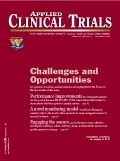What a Form 483 Really Means
Readers share their experience
What a Form 483 Really Means
Although the public historically has had little awareness of clinical research, our field has recently come to the publics attention in the worst possible way. The media have focused on the tragedies associated with very serious, and unexpected, adverse events that have occurred during recent studies. The most prominent of these are the deaths of an 18-year-old subject in a gene transfer study at the University of Pennsylvania and of a 24-year-old healthy volunteer in an asthma challenge study at The Johns Hopkins University.
Public discussions of these tragedies in the lay media have resulted in congressional hearings and other investigations into the conduct of clinical research and a perceived lack of adequate oversight to protect the rights and welfare of human research subjects. These inquiries have led to enhanced scrutiny of all facets of the clinical research communitynot only drugs, but also devices and biologics.
As might be predicted, the clinical research community has reacted in a way that borders on paranoiaparanoia at the prospect of an FDA audit resulting in the issuance of the dreaded Form 483, an action that some liken to the kiss of death for the recipient of such a document. We would like to suggest a different way to look at 483s to foster cooperation between researchers and regulators instead of fear.
What a 483 isand isnt. After inspecting a food, drug, medical device, or biologic establishment, FDA prepares a written report of its inspection findings, following a debriefing. This report is intended primarily for internal FDA use and is not provided to the inspected institution at the conclusion of the on-site visit. To provide the facility with its own written list of discrepancies noted during the inspection, FDA developed form FDA 483, Notice of Inspectional Observations, issued by the field investigator.Form 483 should contain only those observations that can be directly linked to a violation of regulationsnot suggestions, guidance, or other comments. Although the 483 does not contain references to the regulations, each observation should be directly traceable to a section of the applicable regulations.
Items placed on a form 483 are the opinion of the FDA investigator on the scene, and may be subject to review by others within FDA. Current FDA policy requires that the agency write a follow-up letter to clinical investigators and IRBs. When the items on the 483 are confirmed in that letter, they may be taken as an official FDA position. Conversely, there is no guarantee that the follow-up letter will be limited to the items listed on the 483, as additional review by FDA headquarters may identify significant regulatory violations that were not listed on the 483, which will be included in the follow-up letter.
Nevertheless, this does not mean that a 483 should be ignored. A recipient of a 483 should promptly respond to FDA. An effective response addresses each item, indicating agreement and either providing a timeline for correction or requesting clarification of what FDA requires.
Intended to teach, not punish. Our colleagues at the Office of Human Research Protections (OHRP) in the Department of Health and Human Services (HHS), in concert with their colleagues at FDAs Office for Human Research Trials (OHRT), remind us to keep our focus on a culture of conscience as much as a culture of compliance. They also encourage us to envision a fully systemic Human Research Protections Program that assures each sponsor, site, and other constituent of the clinical research enterprise that the others are executing their responsibilities. To make such a focus a reality, we believe that it is necessary to reassert the original intent of the 483to be an instrument of prompt notification to allow the inspected entity an opportunity for correction and improvement, not an instrument of punishment.
Over the past six years, in particular, we in clinical research have been subjected to much debate about whether the system designed to protect research subjects is in jeopardy. Instead of debating whether the system is broken or irreparable, perhaps it would be more helpful to ascertain how is it incompleteand what can we do to complete it. To us, this is one of the core messages that Drs. Koski and LePay have been tirelessly trying to convey to anyone who will listen. A good understanding of the way FDA uses the 483, and what it means to receive one, can assist in that effort.
Felix Khin-Maung-Gyi*is CEO, Paul Goebelis vice president, andMatthew Whalenis president of Chesapeake Research Review, Inc., The Chesapeake Building, 9017 Red Branch Road, Suite 100, Columbia, MD 21045, (410) 884-2900, e-mail: felix@irbinfo.com, www.chesapeakeirb.com.
*To whom correspondence should be addressed

Driving Diversity with the Integrated Research Model
October 16th 2024Ashley Moultrie, CCRP, senior director, DEI & community engagement, Javara discusses current trends and challenges with achieving greater diversity in clinical trials, how integrated research organizations are bringing care directly to patients, and more.
AI in Clinical Trials: A Long, But Promising Road Ahead
May 29th 2024Stephen Pyke, chief clinical data and digital officer, Parexel, discusses how AI can be used in clinical trials to streamline operational processes, the importance of collaboration and data sharing in advancing the use of technology, and more.
Zerlasiran Achieves Significant Sustained Reduction in Lipoprotein(a) Levels with Infrequent Dosing
November 20th 2024Zerlasiran, a novel siRNA therapy, demonstrated over 80% sustained reductions in lipoprotein(a) levels with infrequent dosing in the Phase II ALPACAR-360 trial, highlighting its potential as a safe and effective treatment for patients at high risk of cardiovascular disease.